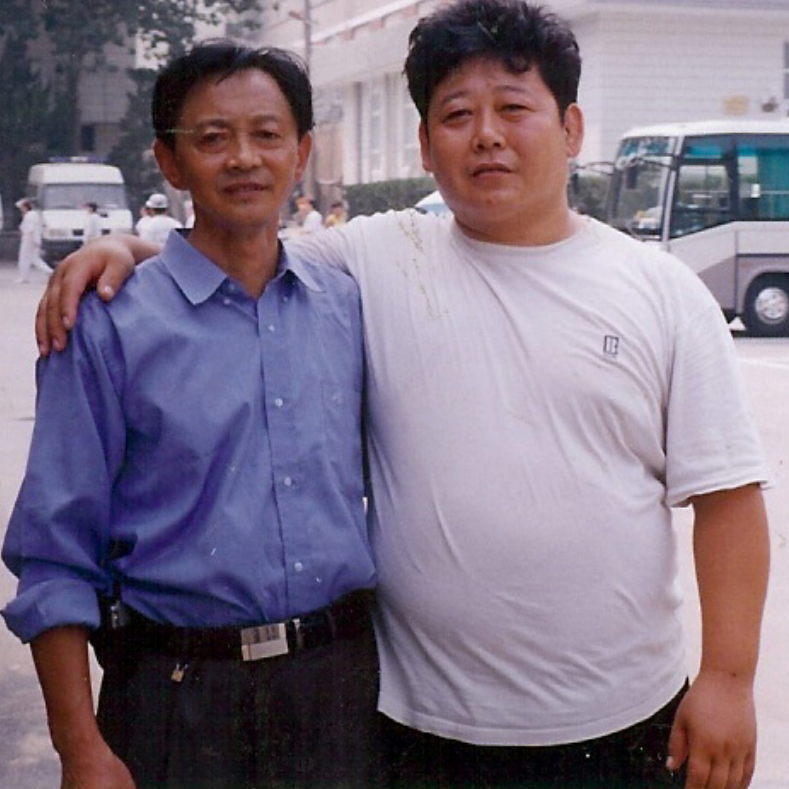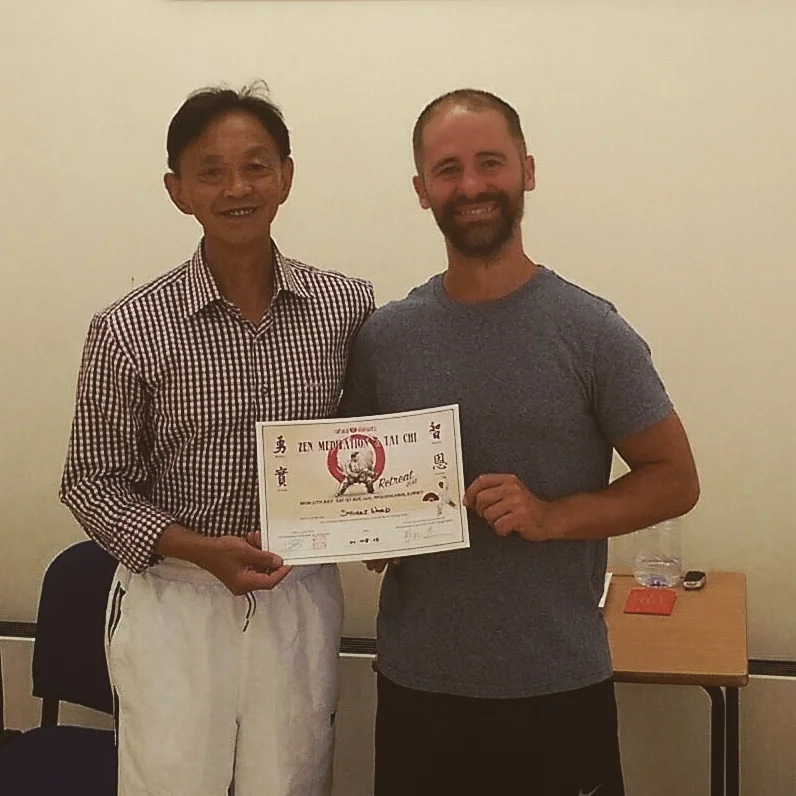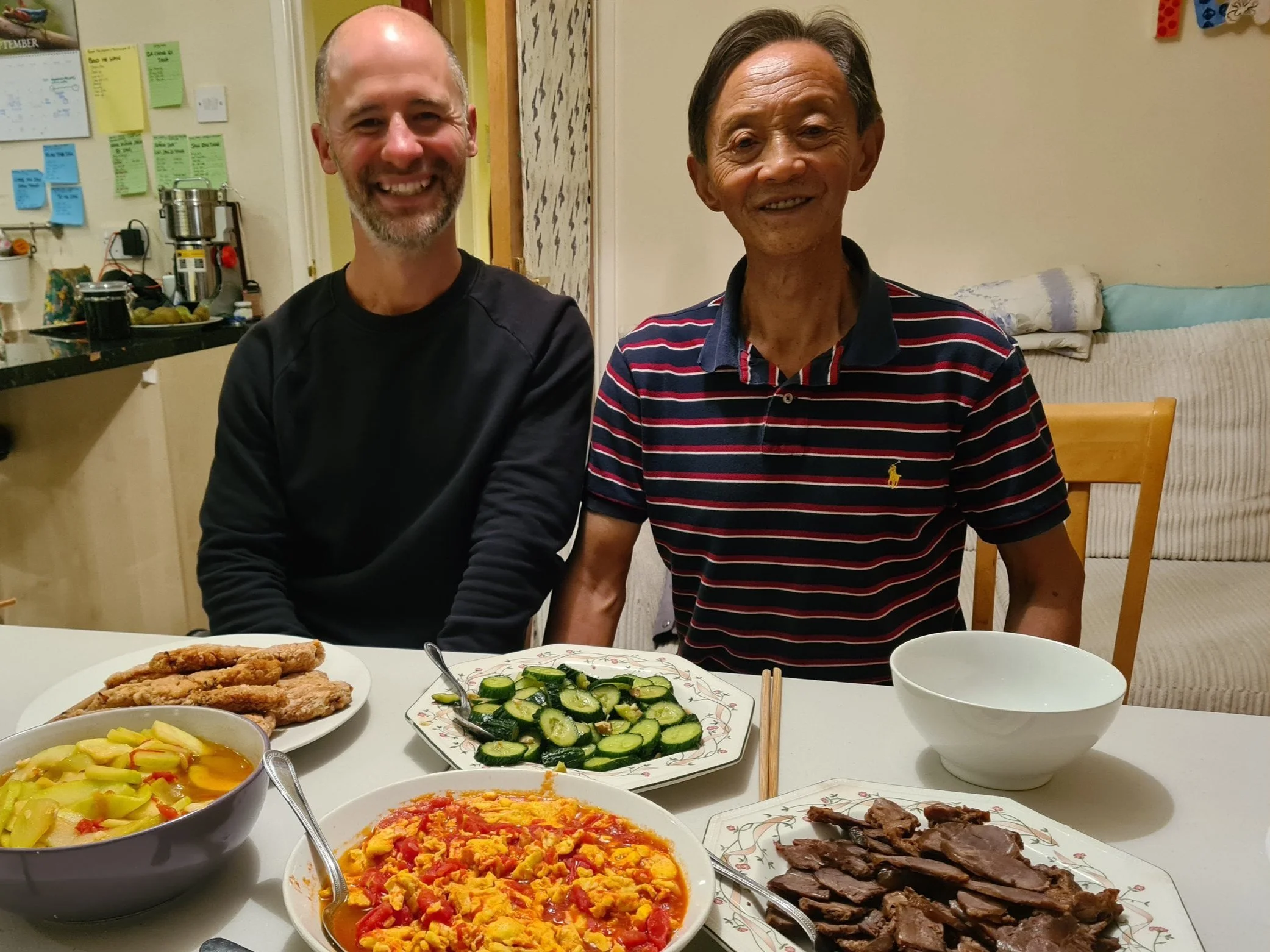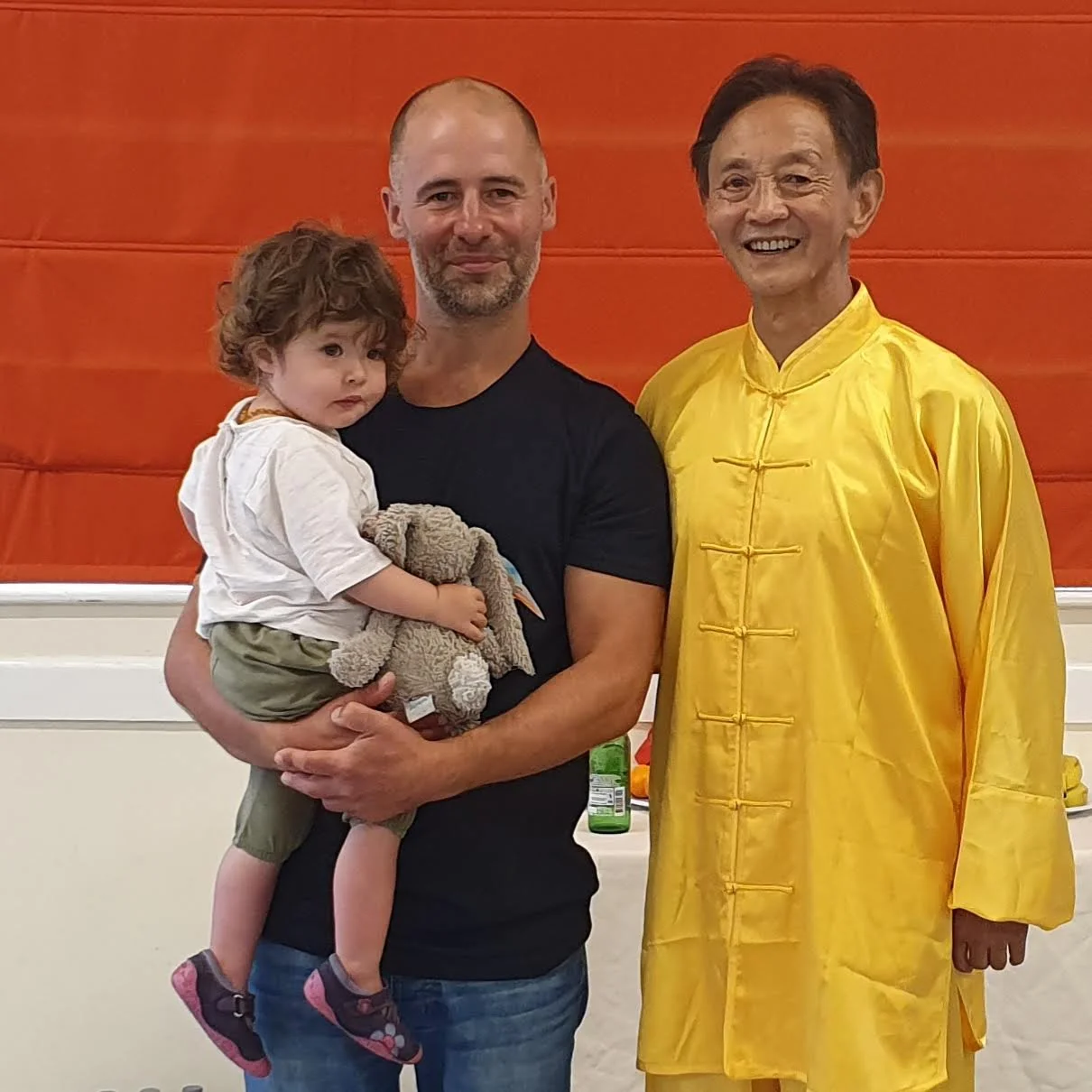Chen Tai Chi With Grandmaster Gou
2018 marks my 10th year practising and studying Chen family Taijiquan or Tai Chi as we often label it in the west. To mark this occasion I thought I’d share a bit of my experience learning from my current Tai Chi teacher (Shifu) Grandmaster Gou.
I first met Gou Kong Jie at my original Chen Tai Chi teacher’s (Paul Lockyer) Bai Shi ceremony in March 2012. After some time training with Grandmaster Gou, Paul was accepted as a disciple/ apprentice. This was a real honor for Paul as unlike many Tai Chi masters Grandmaster Gou (GMG) is very careful who he chooses to take on as a disciple. Despite his 45 years of teaching Tai Chi in China and the UK, he has only accepted 30 disciples to date. To celebrate this event GMG taught a two day workshop over the weekend in Bournemouth, introducing Paul’s students to his training methods.
My first workshop with Grandmaster Gou in March 2012.
The first thing that struck me about GMG’s teaching in the workshop was it’s clarity. He started with a Qi Gong warm-up then went straight into silk reeling (chansujin) basics. These silk reeling basic exercises are perfect in helping you “groove the moves” and get to grips with the Tai Chi body mechanics (Shen Fa) in an accessible way. The silk reeling exercises are little sections of the forms (Taolu) and partner work (Tui Shou) which can be repeated in a loop helping you to develop the circular movement patterns while connecting the upper and lower body.
Paul Lockyer’s (in the middle) Bai Shi ceremony in March 2012 Paul is pictured with two of Grandmaster Gou’s disciples, Douglas (left) and Adrian (right)
GMG’s silk reeling exercises have a very deliberate rhythm with uniquely large and exaggerated circular movements which also have an obvious open and closing element to them. This helps you to quickly see, feel and follow the Tai Chi principles at a basic level. I’ve seen my fair share of Tai Chi masters demonstrating and teaching at their skillful and intricate level, making it very difficult if not impossible for a beginner to grasp the basic concepts and principles early on. There was absolutely no showing off with Gou Kongji just a pure desire to help his students grasp the basic concept of rooting while smoothly transferring weight to motivate a circular movement through the body and right out to the finger tips.
On reflection of this first experience with GMG, I realised that the Tai Chi wasn’t so much taught but rather it was caught by his clear demonstrations. If you weren’t quite getting it he would focus on you and say “watch me” as he further emphasised the point he was trying to make in his movement.
My experience had me “catch” the importance of a strong root. GMG would really emphasise the rooting down, displaying a very low stance before smoothly transferring weight which helped contain, connect and motivate the full body movement.
The second thing that struck me was GMG’s constant smile and patience. It was very clear to me that he was there to enjoy sharing his Tai Chi and make it accessible to all.
This first experience filled me full of excitement as my teacher Paul would now be learning from him privately and on a regular basis. As his new disciple Paul would be taught his system in it’s entirety.
Gou Kongjie with his teacher Chen Zhao Kui’s son, Chen Yu.
Gou Kong Jie was born in 1947 in Henan province China. Like many Tai Chi practitioners he began his martial arts training at a young age with the external Kung Fu styles of Cha Quan, Hong Quan, Mei Hua Quan, Tong Bei Quan and Lian Huan Quan. In 1965 he began learning Chen family Tai Chi from one of the Chen family greats and son of Chen Fa Ke, Chen Zhao Kui. Grandmaster Gou was soon known as one of Chen Zhao Kui’s senior students and paved the way for him to study with other Chen Tai Chi greats such as Feng Zhi Qiang and Hong Jun Sheng. Gou Kong Jie has taught Chen Tai Chi extensively to both university and private students in many provinces around China. Many students would follow him around China to continue learning from him. At the international festival of Tai Chi in 2002 he was awarded the certificate of excellence; this award is very rarely given and reserved for Tai Chi Masters of an exceptional level. He is also co-author of the Tai Chi push hands standard competition rules published by the Chinese state sports council. Gandmaster Gou now lives and continues to teach Tai Chi in Oxford, England.
Chen Taijiquan summer camp with Grandmaster Gou in August 2015
I continued to learn from Paul both privately and in his group classes as he passed on his teachings to me from his training with GMG. Once or twice a year Paul would arrange a workshop where GMG would visit Bournemouth to teach over a weekend with time for private tuition for the more advanced students.
The workshops with GMG continued to highlight the importance he places on the basic silk reeling exercises. Of every 3 hour lesson at least 1 of those hours would be spent grooving the moves of the basics. Transitioning into the form and push hands practice would then make much more sense.
Tai Chi is no different from any other sport or activity in that your skill is built on solid foundations and takes a lot of practice and patience. It’s this foundation that then allows for the more intricate skills to develop. Tai Chi is often shrouded in mystery and apparently full of secrets which are only taught to a select few. From my experience this is nonsense. The real “secrets” are in the basic exercises and can be realised by anyone who is prepared to work hard at them under the guidance of a good teacher. Kung Fu or Gong Fu basically means skill acquired through hard work. This is why GMG will often describe his art as Taiji Gongfu.
I believe that this is the very thing missing with most Tai Chi teachers training methods. They often rush students through the syllabus before they have a chance to grasp the very foundations of the system. You can witness this problem in the Tai Chi competition scene. Competitors with just a few years experience will often demonstrate numerous hand and weapon forms way beyond their skill level which leaves the Tai Chi body mechanics empty, disconnected, weak and pointless. The Tai Chi on show is often nothing more than a choreographed routine performed in slow motion. On the flip side some students are never really pushed or allow themselves to be pushed, preventing them from developing strength and structure within their Tai Chi.
Realising Grandmaster Gou’s authentic and patient teaching methods made me hungry to learn from the source. In January 2016 I requested to be accepted as a student of GMG. Paul was very supportive and opened this door for me and we began to travel from Bournemouth to Oxford together for private training with Grandmaster Gou.
A typical meal Gou Kongjie would make after training
I will never forget my first private lesson in Oxford with GMG. For one it was an early start with me leaving my house in Bournemouth at 5am so we could begin training in Oxford at 7am. Training was hard! So hard I needed the spare change of clothes that Paul advised me to bring. We began with various standing practices (Zhan Zhuang) to develop “root” or grounding with a relaxed upper body. Next was the basic exercise drills, this time though I was taught to add power (Fajing) into them. Finally we practiced partner work or push hands revealing some examples of martial applications for the internal connections developed in the basic exercise drills we had just been working on. After 3 hours of hard practice we were invited back to GMG’s home where he cooked us a simple, traditional Chinese lunch, drank whisky and looked at pictures from his Tai Chi training days in China.
This day was a dream come true for me. Fortunately, I was able to hit the ground running from my years of training with Paul. I also found that the effort of getting up to Oxford with the extra cost of tuition motivated me to up my game. It soon became a weekly event of morning Tai Chi training with afternoon food and whisky (if it was my turn to be driven). As my practice and relationship with GMG developed I began to understand more about his teaching methods.
My bai shi ceromany with Grandmaster Gou and his wife in March 2017. I was given the Chinese name of Yin Gan.
GMG has 3 distinct levels of progression which relate to the size of the circular movements you are performing. As I experienced at the beginning of my training the circles start big with focus on sending energy and intention to the hands. With practice the circles get smaller or as he calls it “middle circles “ with a greater focus on creating the circles deeper in the body until eventually the circular movements become so refined and internal they are small circles. Martially these circular movements are used to generate power, disrupt an opponent’s balance and apply a series of joint locks and throws. For health they serve to massage, strengthen and loosen the body helping improve energetic flow and balance through the meridian channels. From the surface right down to a cellular level we, as in all of nature are made up of a series of spirals. Picture a whirlpool or whirlwind and you can soon visualise the harmonious power that can be created by a spiral. What GMG is trying to teach is the ability to make a circular connection through whole body movement, learn to contain it and then refine until the circular movements work like a drill or ball-baring, creating strong, effortless power. After experiencing this theory in action while pushing hands with him I realsied how much I still had to learn and the potential of his method.
After I got to know GMG a little better through regular training we had a discussion about the possibility of me being taken on as a disciple (tudi).
The Chinese tradition of discipleship comes from both within and outside martial arts circles. After practicing with a teacher who is recognised as a master in their field you may ask them to be taken on as a disciple to take your training to the next level. The request should be made in formal letter outlining your reasons for wanting to be taken on. You will need to have demonstrated a strong desire to learn, with ability, patience and good character. A better term for this in our western culture would be apprentice. Asking to be accepted as a disciple/apprentice means that you recognise the value of their teaching, pledging to learn only from that teacher and show a commitment to train hard. In return you will be taught their method in full. As Chinese culture is heavily focused on “face” and reputation a teacher will not accept you as a disciple if you would be deemed a bad reflection on them. Your job as a disciple is to represent your teacher and carry on their teaching methods to the best of your ability.
I think that in this information age the discipleship process is more important than ever. We have so much information at our finger tips which mean many people in various disciplines are learning from multiple sources. The end result is they never really master any system and lack the grounding to then develop on their own. Robert Greene’s is very clear on this in his book “Mastery” He explains how many of the greats in arts, sports and science start by learning from someone who has already mastered their craft and sticking with them to travel the path with their guidance. There should be a point where you have learnt all you need from that teacher and can then develop on your own.
To quote Swami Satchidananda
“There is no value in digging shallow wells in a hundred places. Decide on one place and dig deep. Even if you encounter a rock, use dynamite and keep going down. If you leave that to dig another well, all the first effort is wasted and there is no proof you won’t hit rock again”
I was honored to be accepted as a disciple to Grandmaster Gou with my formal Bai Shi ceremony marking this occasion in March of 2017.
Gou Kong Jie with me and my daughter Florence for Chinese New Year 2018.
Being a disciple To GMG has felt similar to being accepted into a new family. He will often make lunch for Paul and I after training. Sometimes he will bring breakfast for us before a particularly long or hard training session. Other times we will help him with his favourite pass time, his allotment where he grows traditional Chinese vegetables and help with shopping or travel. On Chinese New Year GMG hosts a big party and will give red envelopes (good luck money) to his disciples children. Because of this relationship my old friends think It’s hilarious to compare me to a middle aged karate kid. Although I pretend to be annoyed, there is a bit of likeness to it.
Gou Kong Jie with me and my daughter Florence July 2019.
Now at the end of 2018 my practice continues. GMG has spent the first part of my discipleship developing my Laoji Yi Lu (old frame) form while integrating push hands/partner work within this frame work. Without me initially realising, my basic silk reeling exercises have been preparing me for Xinjia Yi Lu (new frame) and Er Lu forms. The Xinjia forms were created by GMG’s teachers (Chen Zhaokui’s) father, Chen Fake (1887-1957) in Beijing. The Xinjia forms contain smaller, more intricate circles than the old frame with more fajin (energy release) and qinna (joint locking). GMG has also explained to me how he has created forms specifically for a few of his advanced disciples which suit their specific body structure. Paul Lockyer has a graceful 36 part Laoji form. Doug Elson a 44 part xinjia routine which is strong and powerful. Lampson Leung has 54 part walking stick or cane form with lots of turning and circular movements. I’m looking forward to seeing what he will create for me in the future.
So far my time spent training with GMG has been everything I hoped. Like all humans, gurus and masters he certainly isn’t perfect. He drinks too much whisky and still loves to smoke despite battling cancer at just 25 years old. His Tai Chi forms are not about demonstration and beauty but as a tool to develop martial understanding, skill and health. What impresses me most about GMG is his ability to clearly teach a system. The cleverly put together training methods make you learn things you didn’t realise you were being taught. Teaching the martial applications in Tai Chi is a very tricky task as if taught too early they just become external Kung Fu actions. The skill is to develop a students internal understanding and body mechanics and then at the right time introduce some partner work which allows the student to use the internal movement to create a martial application. This is a process of discovery with the teacher pointing the way. This is real Taijiquan!!
GMG is also unbelievably patient and clearly teaches me for the long hall. If I’m not getting something I have to keep practicing until I do. I’m very grateful for this as that’s exactly how I wish to be taught.
The video below is of Grandmaster Gou demonstrating the old form Laojia Yi Lu in 2003. His form demonstration is different to his own practice as in a demonstration he aims to telegraph and emphasise the movements so as to make it easier to learn. His own personal practice can look quite different at times as the circles are much smaller.








